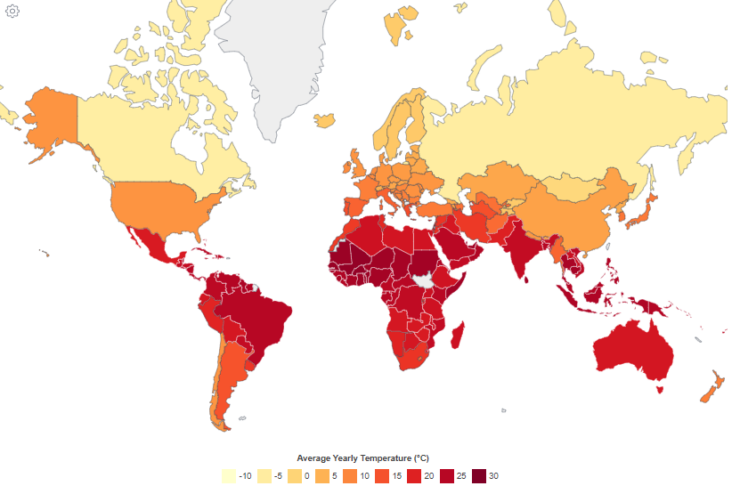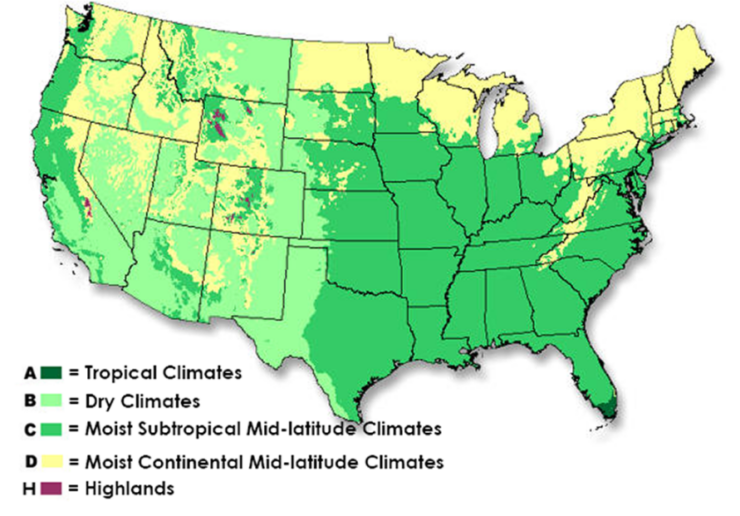Determining which country is the “hottest” is not as straightforward as it might seem. The criteria for this title can vary based on different benchmarks. Let’s dissect the options:
- Peak Temperature in a Year: By this measure, Kuwait takes the crown. In 2021, Nuwaiseeb, a city in Kuwait, recorded a sweltering 53.2°C (127.7°F) on June 22.
- Historical Temperature Highs: If we consider the highest temperatures ever recorded in modern times, the U.S. wins the title. A staggering 56.7°C (134°F) was observed in Death Valley, California back in 1913.
- Seasonal Average: Another perspective could be to consider which country has the hottest average during the summer months, without factoring in cooler winter temperatures.
- Decadal Average: But, for the purposes of this analysis, we’ve chosen perhaps the most comprehensive metric: which country has sustained the highest average temperature throughout an entire year, but measured over the span of 30 years.
This approach provides a holistic view, offering insights into consistent temperature trends rather than temporary spikes or seasonal variations. So, while each method has its validity, our focus here will be on the 30-year year-round temperature average.
Top 10 Hottest Countries in the World 1991-2024 (by average annual temperature °C/°F)
- Mali – 28.83°C / 83.89°F
- Burkina Faso – 28.71°C / 83.68°F
- Senegal – 28.65°C / 83.57°F
- Tuvalu – 28.45°C / 83.21°F
- Djibouti – 28.38°C / 83.08°F
- Mauritania – 28.34°C / 83.01°F
- Bahrain – 28.23°C / 82.81°F
- Palau – 28.04°C / 82.47°F
- Qatar – 28.02°C / 82.44°F
- Gambia – 27.97°C / 82.35°F
Mali is the hottest country in the world, with an average yearly temperature of 83.89°F (28.83°C). Located in West Africa, Mali actually shares borders with both Burkina Faso and Senegal, which follow it on the list. A large part of Mali is covered by the Sahara Desert, and most of the country receives minimal rain, making drought a frequent concern.
Where Are the Earth’s Hottest Countries?

As a Rule, Countries Closer to The Earth’s Equator (zero Degrees Latitude) Experience Warmer Temperatures Year-Round than Countries Farther North or South of The Equator.
As One Moves Closer to The Poles (further North in The Northern Hemisphere or South in The Southern Hemisphere), the Seasonal Weather Variation and Range of Temperatures Experienced Over the Course of A Year Increases, Including Significantly Colder Temperatures in The Winter.
Why Are Temperate Countries, Cooler?
Temperate countries, situated between the scorching equator and the icy poles, experience moderate temperatures. The reasons for their cooler climate, when compared to equatorial regions, are mainly due to Earth’s geometry and axial tilt. Here’s an analytical breakdown:
- Shape of the Earth: Our planet isn’t a perfect sphere; it’s an oblate spheroid. This unique shape plays a vital role in determining temperature distribution. Near the equator, sunlight hits directly, leading to intense heat as sunlight is concentrated over a small area. Contrastingly, as we move towards the poles, the angle of sunlight becomes more slanted, causing it to spread across larger regions. Additionally, polar regions often have snow-covered landscapes which further reflect sunlight, reducing the heat absorbed.
- Atmospheric Thickness: The angle at which sunlight hits the earth also affects how much atmosphere it passes through. At higher latitudes, sunlight travels through a denser layer of the atmosphere. This results in more chances for sunlight to get reflected, deflected, or absorbed by atmospheric components, further diminishing the heat received by these regions.
- Axial Tilt and Seasons: Earth’s 23.5° tilt isn’t just a random angle—it’s responsible for the seasons we experience. For roughly half the year, the Northern Hemisphere tilts towards the sun, making days longer and hotter. Conversely, when the North Pole tilts away from the sun, it’s the Southern Hemisphere’s turn to bask in longer, sunnier days. This tilt ensures that both hemispheres receive a fair share of sunlight and warmth, but at different times of the year.
So, while equatorial regions consistently soak up the sun’s intense rays, temperate countries are influenced by a combination of Earth’s shape, atmospheric depth, and a see-saw of axial tilts, resulting in their generally cooler climate.
Do Changes In Climate Correspond To National Borders?

While geographical features such as lakes and mountain ranges can definitely impact weather and climate, national borders are typically determined by politics rather than geography.
Therefore, national borders tend to have no effect upon climate, weather, and temperatures. Climates and temperatures vary greatly between countries and even within countries. This is especially true in large countries, such as the United States or Russia.
The U.S. states have a huge variety of climates depending on their latitude and proximity to oceans, mountains, or the Great Lakes.
Are the World’s Hottest Countries Getting Hotter?
The world’s temperature records are painting a concerning picture: our planet is warming up. Even the hottest countries aren’t exempt from this trend. Here’s a concise analysis:
- Global Warming is Universal: While some areas might experience more pronounced changes than others, the trend of rising temperatures is global. This means that even the traditionally hottest countries are also seeing upward shifts in their average temperatures.
- Record-breaking Temperatures: The NOAA’s report of July 2021 being the hottest month ever showcases the magnitude of this change. Such records provide tangible evidence of the rapid and unprecedented changes our planet is undergoing.
- Unprecedented Warm Period: Data from trusted organizations, like NASA and the NOAA, stresses that recent years have been exceptionally warm. Specifically, the six years spanning 2014-2020 were hotter than any similar period in the past 171 years. This isn’t just a blip on the radar; it’s part of a significant and sustained trend.
- Human Influence: Many scientific studies have attributed the acceleration in global warming to human activities, especially the emission of greenhouse gases. This means our actions are directly influencing the climatic conditions of our planet.
- Uncertain Future: Despite the overwhelming evidence for global warming, the exact trajectory of future temperatures remains uncertain. Factors influencing this uncertainty include potential changes in human behavior, technological advancements, and the planet’s own unpredictable climate feedback loops.
In conclusion, the world’s hottest countries are not isolated from the global trend of increasing temperatures. However, the magnitude of future changes and our response to them remains a topic of crucial importance and ongoing study.
| Country | Average Yearly Temperature (°C) | Average Yearly Temperature (°F) |
|---|---|---|
| Mali | 28.25 | 82.85 |
| Burkina Faso | 28.25 | 82.85 |
| Kiribati | 28.2 | 82.76 |
| Djibouti | 28 | 82.4 |
| Tuvalu | 28 | 82.4 |
| Senegal | 27.85 | 82.13 |
| Mauritania | 27.65 | 81.77 |
| Maldives | 27.65 | 81.77 |
| Palau | 27.6 | 81.68 |
| Benin | 27.55 | 81.59 |
| Gambia | 27.5 | 81.5 |
| Marshall Islands | 27.4 | 81.32 |
| Ghana | 27.2 | 80.96 |
| Niger | 27.15 | 80.87 |
| Togo | 27.15 | 80.87 |
| Qatar | 27.15 | 80.87 |
| Bahrain | 27.15 | 80.87 |
| Seychelles | 27.15 | 80.87 |
| Somalia | 27.05 | 80.69 |
| United Arab Emirates | 27 | 80.6 |
| Sri Lanka | 26.95 | 80.51 |
| Sudan | 26.9 | 80.42 |
| Brunei | 26.85 | 80.33 |
| Nigeria | 26.8 | 80.24 |
| Cambodia | 26.8 | 80.24 |
| Saint Vincent And The Grenadines | 26.8 | 80.24 |
| Guinea Bissau | 26.75 | 80.15 |
| Samoa | 26.7 | 80.06 |
| Grenada | 26.65 | 79.97 |
| Chad | 26.55 | 79.79 |
| Singapore | 26.45 | 79.61 |
| Ivory Coast | 26.35 | 79.43 |
| Thailand | 26.3 | 79.34 |
| Sierra Leone | 26.05 | 78.89 |
| Guyana | 26 | 78.8 |
| Barbados | 26 | 78.8 |
| Antigua And Barbuda | 26 | 78.8 |
| Indonesia | 25.85 | 78.53 |
| Philippines | 25.85 | 78.53 |
| Micronesia | 25.85 | 78.53 |
| Trinidad And Tobago | 25.75 | 78.35 |
| Guinea | 25.7 | 78.26 |
| Suriname | 25.7 | 78.26 |
| Solomon Islands | 25.65 | 78.17 |
| Oman | 25.6 | 78.08 |
| Comoros | 25.55 | 77.99 |
| Eritrea | 25.5 | 77.9 |
| Saint Lucia | 25.5 | 77.9 |
| Malaysia | 25.4 | 77.72 |
| Panama | 25.4 | 77.72 |
| Venezuela | 25.35 | 77.63 |
| Kuwait | 25.35 | 77.63 |
| Liberia | 25.3 | 77.54 |
| Belize | 25.3 | 77.54 |
| Papua New Guinea | 25.25 | 77.45 |
| Timor Leste | 25.25 | 77.45 |
| Tonga | 25.25 | 77.45 |
| Cuba | 25.2 | 77.36 |
| Gabon | 25.05 | 77.09 |
| Bangladesh | 25 | 77 |
| Brazil | 24.95 | 76.91 |
| Jamaica | 24.95 | 76.91 |
| Haiti | 24.9 | 76.82 |
| Nicaragua | 24.9 | 76.82 |
| Central African Republic | 24.9 | 76.82 |
| Bahamas | 24.85 | 76.73 |
| Costa Rica | 24.8 | 76.64 |
| Kenya | 24.75 | 76.55 |
| Saudi Arabia | 24.65 | 76.37 |
| Cameroon | 24.6 | 76.28 |
| Dominican Republic | 24.55 | 76.19 |
| Republic Of The Congo | 24.55 | 76.19 |
| Equatorial Guinea | 24.55 | 76.19 |
| Colombia | 24.5 | 76.1 |
| Saint Kitts And Nevis | 24.5 | 76.1 |
| Vietnam | 24.45 | 76.01 |
| El Salvador | 24.45 | 76.01 |
| Fiji | 24.4 | 75.92 |
| Dr Congo | 24 | 75.2 |
| Vanuatu | 23.95 | 75.11 |
| Yemen | 23.85 | 74.93 |
| Mozambique | 23.8 | 74.84 |
| Sao Tome And Principe | 23.75 | 74.75 |
| India | 23.65 | 74.57 |
| Paraguay | 23.55 | 74.39 |
| Honduras | 23.5 | 74.3 |
| Guatemala | 23.45 | 74.21 |
| Cape Verde | 23.3 | 73.94 |
| Uganda | 22.8 | 73.04 |
| Laos | 22.8 | 73.04 |
| Madagascar | 22.65 | 72.77 |
| Algeria | 22.5 | 72.5 |
| Mauritius | 22.4 | 72.32 |
| Tanzania | 22.35 | 72.23 |
| Dominica | 22.35 | 72.23 |
| Ethiopia | 22.2 | 71.96 |
| Egypt | 22.1 | 71.78 |
| Malawi | 21.9 | 71.42 |
| Ecuador | 21.85 | 71.33 |
| Libya | 21.8 | 71.24 |
| Australia | 21.65 | 70.97 |
| Angola | 21.55 | 70.79 |
| Bolivia | 21.55 | 70.79 |
| Botswana | 21.5 | 70.7 |
| Iraq | 21.4 | 70.52 |
| Zambia | 21.4 | 70.52 |
| Eswatini | 21.4 | 70.52 |
| Mexico | 21 | 69.8 |
| Zimbabwe | 21 | 69.8 |
| Pakistan | 20.2 | 68.36 |
| Namibia | 19.95 | 67.91 |
| Burundi | 19.8 | 67.64 |
| Peru | 19.6 | 67.28 |
| Tunisia | 19.2 | 66.56 |
| Israel | 19.2 | 66.56 |
| Malta | 19.2 | 66.56 |
| Cyprus | 18.45 | 65.21 |
| Jordan | 18.3 | 64.94 |
| Rwanda | 17.85 | 64.13 |
| South Africa | 17.75 | 63.95 |
| Syria | 17.75 | 63.95 |
| Uruguay | 17.55 | 63.59 |
| Iran | 17.25 | 63.05 |
| Morocco | 17.1 | 62.78 |
| Lebanon | 16.4 | 61.52 |
| Greece | 15.4 | 59.72 |
| Portugal | 15.15 | 59.27 |
| Turkmenistan | 15.1 | 59.18 |
| Argentina | 14.8 | 58.64 |
| Monaco | 13.55 | 56.39 |
| Italy | 13.45 | 56.21 |
| Spain | 13.3 | 55.94 |
| Myanmar | 13.05 | 55.49 |
| Afghanistan | 12.6 | 54.68 |
| Uzbekistan | 12.05 | 53.69 |
| Azerbaijan | 11.95 | 53.51 |
| Lesotho | 11.85 | 53.33 |
| San Marino | 11.85 | 53.33 |
| South Korea | 11.5 | 52.7 |
| Albania | 11.4 | 52.52 |
| Japan | 11.15 | 52.07 |
| Turkey | 11.1 | 51.98 |
| Croatia | 10.9 | 51.62 |
| France | 10.7 | 51.26 |
| Serbia | 10.55 | 50.99 |
| Bulgaria | 10.55 | 50.99 |
| New Zealand | 10.55 | 50.99 |
| Montenegro | 10.55 | 50.99 |
| Bosnia And Herzegovina | 9.85 | 49.73 |
| Hungary | 9.75 | 49.55 |
| Belgium | 9.55 | 49.19 |
| Moldova | 9.45 | 49.01 |
| Ireland | 9.3 | 48.74 |
| Netherlands | 9.25 | 48.65 |
| Slovenia | 8.9 | 48.02 |
| Romania | 8.8 | 47.84 |
| Luxembourg | 8.65 | 47.57 |
| United States | 8.55 | 47.39 |
| Germany | 8.5 | 47.3 |
| United Kingdom | 8.45 | 47.21 |
| Chile | 8.45 | 47.21 |
| Ukraine | 8.3 | 46.94 |
| Nepal | 8.1 | 46.58 |
| Poland | 7.85 | 46.13 |
| Andorra | 7.6 | 45.68 |
| Czech Republic | 7.55 | 45.59 |
| Denmark | 7.5 | 45.5 |
| Bhutan | 7.4 | 45.32 |
| Armenia | 7.15 | 44.87 |
| China | 6.95 | 44.51 |
| Slovakia | 6.8 | 44.24 |
| Kazakhstan | 6.4 | 43.52 |
| Austria | 6.35 | 43.43 |
| Lithuania | 6.2 | 43.16 |
| Belarus | 6.15 | 43.07 |
| Georgia | 5.8 | 42.44 |
| North Korea | 5.7 | 42.26 |
| Liechtenstein | 5.65 | 42.17 |
| Latvia | 5.6 | 42.08 |
| Switzerland | 5.5 | 41.9 |
| Estonia | 5.1 | 41.18 |
| Sweden | 2.1 | 35.78 |
| Tajikistan | 2 | 35.6 |
| Iceland | 1.75 | 35.15 |
| Finland | 1.7 | 35.06 |
| Kyrgyzstan | 1.55 | 34.79 |
| Norway | 1.5 | 34.7 |
| Mongolia | -0.7 | 30.74 |
| Russia | -5.1 | 22.82 |
| Canada | -5.35 | 22.37 |
FAQ
https://youtu.be/W2oW0Ct5A54
What is the hottest country in Europe?
Answer: Spain typically registers some of the highest summer temperatures in Europe, especially in its southern parts. However, several countries in Southern Europe, including Greece and Italy, also experience very hot summers.
Is Croatia hotter than Spain?
Answer: Generally, Spain has hotter summers than Croatia, especially in inland areas and the south of Spain. Croatia’s coastal regions might have milder temperatures due to the Adriatic Sea’s influence.
Where is hotter: Greece or Spain?
Answer: Both countries can get very hot in the summer, especially in their respective inland areas. On average, some parts of Spain, like Andalusia, might register higher temperatures than many regions in Greece. However, both nations experience hot Mediterranean summers.
Where is not too hot in Europe?
Answer: Northern European countries like Norway, Sweden, Finland, Denmark, and Iceland generally have milder summers. The British Isles, parts of Ireland, and the Scottish Highlands are also cooler compared to much of Southern Europe.
Is Croatia hot in August?
Answer: Yes, Croatia can be quite hot in August, especially in its coastal areas and islands. August is one of the peak summer months, and temperatures frequently rise, making it a popular time for beach tourism.
What country is too hot to live?
Answer: While “too hot” is subjective and can vary based on personal preference, some countries have extreme temperatures that can be challenging. In Europe, no country is consistently “too hot to live.”
However, globally, places like parts of the Empty Quarter in Saudi Arabia or the Lut Desert in Iran have recorded some of the highest ground temperatures, making them inhospitable without modern conveniences.
Final Words
As our 30-year examination indicates, the world’s hottest countries have not only maintained their positions in terms of average annual temperatures, but many have also witnessed a sharp incline in temperatures, further underscoring the concerning effects of global warming. The Earth’s geometry and axial tilt, while natural phenomena, have been accentuated in their effects due to human-induced climate change.
The importance of understanding the intrinsic nature of Earth’s temperature distribution cannot be understated, especially when we consider the broader impacts on ecosystems, agriculture, and human health. For the sake of our planet’s future and our own well-being, comprehending these temperature trends is paramount in making informed decisions and taking actionable steps toward a more sustainable future.













